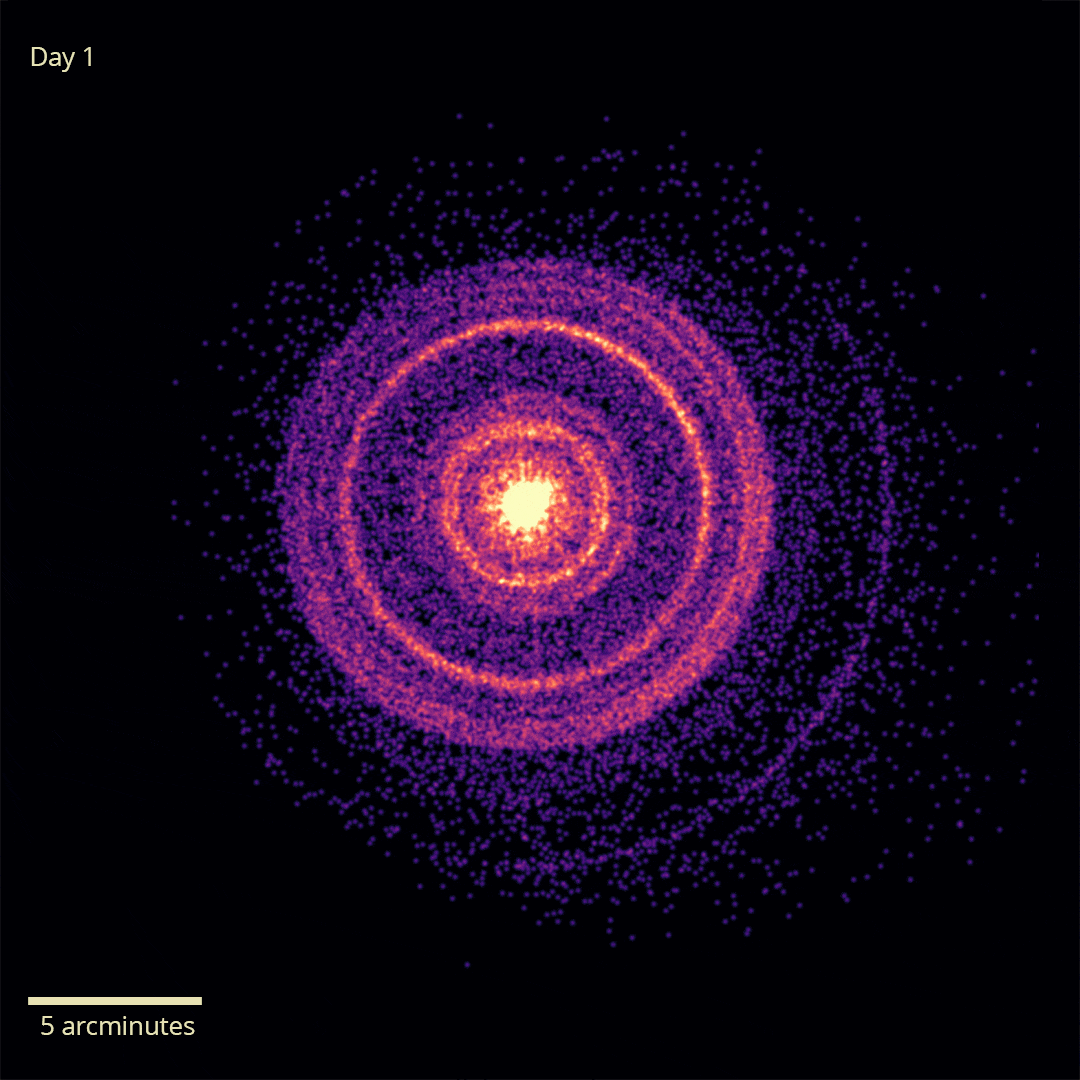Scientists Record GRB 221009A, the Brightest Gamma-Ray Burst in Cosmic History

A team of scientists from 17 countries, including physicists from HSE University, analysed early photometric and spectroscopic data of GRB 221009A, the brightest gamma-ray burst ever recorded. The data was obtained at the Sayan Observatory one hour and 15 minutes after the emission was registered. The researchers detected photons with an energy of 18 teraelectronvolts (TeV). Theoretically, such high-energy particles should not reach Earth, but data analysis has confirmed that they can. The results challenge the theory of gamma radiation absorption and may point to unknown physical processes. The study has been published in Astronomy & Astrophysics.
Gamma-ray bursts are the most powerful cosmic explosions, releasing an immense amount of energy. These bursts were first detected in the gamma range, giving them their name. They occur during the death of massive stars or the collision of neutron stars.
On October 9, 2022, several space-based gamma-ray observatories detected an exceptionally bright burst, later classified as GRB 221009A—the most powerful gamma-ray burst ever recorded. The burst's unprecedented brightness was so intense that it caused malfunctions in the gamma-ray telescopes of most orbital observatories, including Fermi, INTEGRAL, and Konus-Wind. In addition, the gamma radiation that reached Earth caused a significant disturbance in the ionosphere.

The radiation energy emitted by GRB 221009A over just one hundred seconds was equivalent to the combined radiation of one billion Suns over 97 billion years, even though the age of the Universe is only 13.8 billion years. Such events occur extremely rarely—once in a thousand years. However, it wasn't just the brightness that made GRB 221009A unique. The burst occurred 2.4 billion light-years from Earth, which is relatively close by the standards of the Universe. For comparison, the most distant known burst was recorded at a distance of approximately 13.2 billion light-years. As a result, the event sparked significant interest in the scientific community: by the end of 2022, seven papers had been published, and now there are more than 200.
Researchers are continuing to analyse data on GRB 221009A. For the first time, an international team of scientists from 17 countries, including researchers from HSE University, analysed data from photometric and spectroscopic observations collected at the Sayan Observatory one hour and 15 minutes after the gamma-ray burst was detected.
Photometric and spectroscopic observations are methods used to measure the intensity of electromagnetic radiation in the visible and infrared ranges, as well as its 'colour composition' (spectrum). The former makes it possible to determine the brightness of an object, while the latter reveals the chemical elements present in the emitting object and along the radiation path to the observer.
According to the scientists, the data analysis suggests prolonged activity of the central engine—a compact, massive object responsible for generating gamma-ray burst radiation. They also note that the environment surrounding the explosion changed from a denser one, shaped by the stellar wind, to a more rarefied one, similar to the interstellar medium.
The researchers were particularly interested in photons with an energy of 18 teraelectronvolts (TeV), which were recorded from the GRB 221009A source by the Large High Altitude Air Shower Observatory (LHAASO). Theoretically, such high-energy photons should not be detectable due to their interaction with optical photons in the intergalactic medium on their way to the observer; however, they somehow still reached Earth. The analysis reveals that the detection of photons with an energy of 18 TeV is unlikely according to existing models of intergalactic background radiation, and their detection from gamma-ray burst sources remains a unique occurrence.

Sergey Belkin
'The detection of high-energy photons allows us to test fundamental laws of physics, such as the constancy of the speed of light. However, there is no cause for concern yet, as the detection of such high-energy photons can still be explained by uncertainties in the intergalactic background radiation model, rather than a violation of Lorentz invariance—the fundamental principle stating that the speed of light is constant in all reference frames,' explains Sergey Belkin, doctoral student at the Joint Department of Space Physics with the Space Research Institute (RAS) of the HSE Faculty of Physics.
See also:
HSE Researchers Teach Neural Network to Distinguish Origins from Genetically Similar Populations
Researchers from the AI and Digital Science Institute, HSE Faculty of Computer Science, have proposed a new approach based on advanced machine learning techniques to determine a person’s genetic origin with high accuracy. This method uses graph neural networks, which make it possible to distinguish even very closely related populations.
HSE Economists Reveal the Secret to Strong Families
Researchers from the HSE Faculty of Economic Sciences have examined the key factors behind lasting marriages. The findings show that having children is the primary factor contributing to marital stability, while for couples without children, a greater income gap between spouses is associated with a stronger union. This is the conclusion reported in Applied Econometrics.
Fifteen Minutes on Foot: How Post-Soviet Cities Manage Access to Essential Services
Researchers from HSE University and the Institute of Geography of the Russian Academy of Sciences analysed three major Russian cities to assess their alignment with the '15-minute city' concept—an urban design that ensures residents can easily access essential services and facilities within walking distance. Naberezhnye Chelny, where most residents live in Soviet-era microdistricts, demonstrated the highest levels of accessibility. In Krasnodar, fewer than half of residents can easily reach essential facilities on foot, and in Saratov, just over a third can. The article has been published in Regional Research of Russia.
HSE Researchers Find Counter-Strike Skins Outperform Bitcoin and Gold as Alternative Investments
Virtual knives, custom-painted machine guns, and gloves are common collectible items in videogames. A new study by scientists from HSE University suggests that digital skins from the popular video game Counter-Strike: Global Offensive (CS:GO) rank among the most profitable types of alternative investments, with average annual returns exceeding 40%. The study has been published in the Social Science Research Network (SSRN), a free-access online repository.
HSE Neurolinguists Reveal What Makes Apps Effective for Aphasia Rehabilitation
Scientists at the HSE Centre for Language and Brain have identified key factors that increase the effectiveness of mobile and computer-based applications for aphasia rehabilitation. These key factors include automated feedback, a variety of tasks within the application, extended treatment duration, and ongoing interaction between the user and the clinician. The article has been published in NeuroRehabilitation.
'Our Goal Is Not to Determine Which Version Is Correct but to Explore the Variability'
The International Linguistic Convergence Laboratory at the HSE Faculty of Humanities studies the processes of convergence among languages spoken in regions with mixed, multiethnic populations. Research conducted by linguists at HSE University contributes to understanding the history of language development and explores how languages are perceived and used in multilingual environments. George Moroz, head of the laboratory, shares more details in an interview with the HSE News Service.
Slim vs Fat: Overweight Russians Earn Less
Overweight Russians tend to earn significantly less than their slimmer counterparts, with a 10% increase in body mass index (BMI) associated with a 9% decrease in wages. These are the findings made by Anastasiia Deeva, lecturer at the HSE Faculty of Economic Sciences and intern researcher in Laboratory of Economic Research in Public Sector. The article has been published in Voprosy Statistiki.
Scientists Reveal Cognitive Mechanisms Involved in Bipolar Disorder
An international team of researchers including scientists from HSE University has experimentally demonstrated that individuals with bipolar disorder tend to perceive the world as more volatile than it actually is, which often leads them to make irrational decisions. The scientists suggest that their findings could lead to the development of more accurate methods for diagnosing and treating bipolar disorder in the future. The article has been published in Translational Psychiatry.
Scientists Develop AI Tool for Designing Novel Materials
An international team of scientists, including researchers from HSE University, has developed a new generative model called the Wyckoff Transformer (WyFormer) for creating symmetrical crystal structures. The neural network will make it possible to design materials with specified properties for use in semiconductors, solar panels, medical devices, and other high-tech applications. The scientists will present their work at ICML, a leading international conference on machine learning, on July 15 in Vancouver. A preprint of the paper is available on arxiv.org, with the code and data released under an open-source license.
HSE Linguists Study How Bilinguals Use Phrases with Numerals in Russian
Researchers at HSE University analysed over 4,000 examples of Russian spoken by bilinguals for whom Russian is a second language, collected from seven regions of Russia. They found that most non-standard numeral constructions are influenced not only by the speakers’ native languages but also by how frequently these expressions occur in everyday speech. For example, common phrases like 'two hours' or 'five kilometres’ almost always match the standard literary form, while less familiar expressions—especially those involving the numerals two to four or collective forms like dvoe and troe (used for referring to people)—often differ from the norm. The study has been published in Journal of Bilingualism.


